To find out more, visit https://www.savagearms.com/firearms/model/S1200.
To purchase on GunsAmerica.com, click this link: https://www.gunsamerica.com/Search.aspx?T=S1200.
It’s been more than 40 years ago, but the memory remains vividly imprinted in my mind. My father nudged me awake in the predawn darkness, helping me dress and then carrying me outside still half asleep—my young mind torn between the excitement of what unknown adventure lie ahead and the irresistible pull of more slumber. Adventure won out as for the first time ever, I finally got to join my father on a hunting trip.
I don’t remember exactly what time of year it was. Seems like it was maybe early Fall, not too cold and still a number of leaves—most of them changed to reds, browns and yellows, drifting loose from the trees. I remember seeing a few squirrels, and I remember yelling to alert my father as one bounded from behind a tree as he picked me up to carry me along a path flooded with water. The land we hunted was on the fringes of the vast and storied Great Dismal Swamp of Virginia, so there was both plenty of water and plenty of gray squirrels among the hardwoods. The one thing I don’t recall is if we got anything that day. (Being a squirmy 7-year-old on his first hunt, I seriously doubt that we did.)
But I do recall two other momentous firsts later that morning. One was getting to shoot my first gun ever—a .22 LR Marlin lever-action. The other was getting to shoot my first shotgun—a break-open single-shot Stevens in .410. My dad still owns both those guns, and I borrow them frequently, particularly when I return to the woods to recreate that first hunting adventure with my children or even when sneaking away for a solo chance to hunt.
I have to admit, while the precision-shooting skills employed when trying to deliver a .22-caliber bullet into the target area provided by a squirrel’s noggin at 30 yards is a fun challenge, the close-quarters limitations of the slender .410’s payload makes for a different kind of, but no less fun, woodlands test. The slender-styling and light weight of that break-open Stevens is appealing when it comes to lugging a firearm through the woods for an entire morning or afternoon. Over the years, I can’t recall how many squirrels and rabbits the old .410 has accounted for, but I can attest, it has been quite a few.
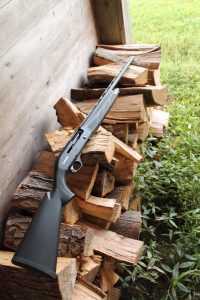
The S1200 combines the proven inertia-driven recoil system with modern styling and a bargain price that will please many of today’s cost-conscious sportsmen.
For all of this, Stevens has always held a special place in my heart, if not always in my consciousness. Upon graduating to hunting with larger shotguns for larger game, other modern mainstream scattergun manufacturers came to dominate my attention over the years until the Stevens brand lived more as a novelty than a serious contender when it came to buying a new shotgun for me.
SPECS
- Chambering: 12 Ga., 3-inch
- Barrel: 28 or 26 inches
- OA Length: 49½ inches
- Weight: 6¼ pounds
- Stock: synthetic (walnut available)
- Sights: gold bead front
- Action: Semi-auto
- Finish: matte black or camo available
- Capacity: 4+1
- MSRP: $571-$681
A New Opportunity
Their S1200 may well change all that…for me and many other hunters as well. Introduced earlier this year as the company’s first-ever semi-auto shotgun, the S1200 is powered using a very smooth, fast Benelli-esque inertia recoil system but comes with a very unBenelli-esque price—starting at well under $600, for a semi-auto shotgun. To those readers of shotgun reviews who often complain everything we outdoor writers choose to cover far exceeds the average man’s paycheck, I say “read on,” this review—and gun—is for you. It is also for anyone who likes a great value for their hard-earned money.
Again, at the heart of the S1200 is the inertia-driven system, which typically utilizes fewer operational parts than a gas-operated shotgun. So how does an inertia gun work? When a shot is fired and the load is blown out through the barrel, the opposite energy, or recoil as we commonly call it, generates enough energy to push the entire gun back as the bolt carrier remains stable, compressing against a tight inertia spring. Loaded, the spring then slams the bolt rearward, ejecting the spent shell. A recoil spring then sends the bolt forward again, as the new shell is fed from the magazine.

The S1200 breaks down quickly and easily for cleaning. Note the slender plug (the long narrow rod) that slips easily into the forward end of the magazine tube, via a small opening beneath the end cap.
With fewer parts to operate the gun internally, it translates to fewer parts to take up space inside the forend of the gun, which allows the forend to be more slender than those typically found on gas-operated shotguns. For the same reason, the gun is also typically a bit lighter. It is also faster cycling for rapid follow-up shots where that first one didn’t do the trick or when trying to knock down multiple targets such as true doubles on a clays course or a pair of incoming geese. The S1200 is chambered to accommodate 3-inch to 2¾-inch shells, utilizes a rotating bolt and comes with either a 28- or 26-inch vent-rib steel barrel with either a blued or camo finish. To that end, the gun itself is available with a synthetic stock in a no frills matte black overall finish (like my test gun) or Mossy Oak Shadow Grass or Mossy Oak Bottomland camouflage patterns. For a more traditional look, the S1200 is also available with an attractive walnut stock, that model coming with a stainless bolt and matte black barrel finish.
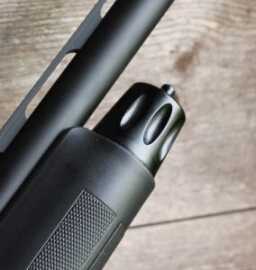
The forend is knurled to allow for quick and easy removal and gun disassembly in the field or on the bench. It comes with a front sling attachment already built in.
The gun comes with five choke tubes (though my test sample gun only had a modified) and is compatible with the popular and proven Beretta Mobilchoke system. The silver trigger, gold front sight bead and silver-colored Stevens logo on both sides of the receiver add attractive flourishes to the otherwise totally black gun. The safety is traditionally located at the upper rear portion of the oversized trigger guard, which makes shooting with heavy gloves much easier for those who want this scattergun for those mercury-challenged mornings in a duck blind or among the skim ice in flooded timber.
The forend and pistol grip are textured, while a few twists of the knurled end cap allows the slender plug to be removed or re-inserted without fear of losing springs or other parts and allows for the quick and easy takedown of the shotgun. With the plug, magazine capacity is limited to two shells; without it can take four, plus one in the chamber of course. The S1200 comes sling ready as the end cap and bottom of the stock both come outfitted with sling attachments. A generously sized rubberized recoil pad mitigates felt recoil at the shoulder.
So how does it feel? Quite simply, the S1200 feels like a dream in the hand. Again, with the fewer parts needed for the inertia recoil system, the forend can be made to be slender, allowing a better fit in the majority of human beings’ hands. Length of pull measures out at 14¼ inches. At 6.8 pounds (with the 26-inch barrel; add .10 of a pound for the longer one) the gun feels nimble in the hand and when swinging for shots. It balances like a more expensive inertia-driven shotgun, which brings us back to price.
[one_half]
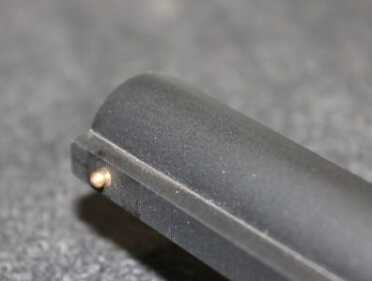
The barrel of the S1200 has a single gold, front bead sight for increased visibility (and a classic touch of styling).
[/one_half]
[one_half_last]

Because there is no gas to siphon off recoil, many inertia-powered guns, like the S1200, boast generous recoil pads.
[/one_half_last]
Most hunters or sporting clays shooters looking to buy a new semi-auto shotgun can expect to spend well above the $1,000 mark, a ghastly sum to many of us budgetarily challenged sportsmen. The S1200, despite all of the noted features, skims well below that radar, with the basic matte black synthetic model listing an MSRP of just $571. For the camo version, the price creeps to a still easy $626 and the walnut version is $681.
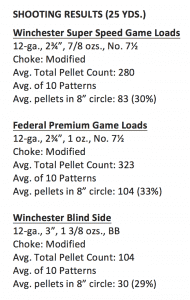 The Test
The Test
For testing, I took the gun out to my brother’s farm and shot patterns from a Champion shooting rest at 25 yards and then shot from the shoulder at both paper targets and hand-thrown clays. As noted, the gun was nimble to point and light in swinging. Switching between both field loads and waterfowl loads, recoil was still quite manageable.
Patterns at the reasonable target distances and even throwing them out farther to 40 yards were quite respectable with the gun’s point-of-aim being right on straight out of the box. I never once experienced ragged patterns no matter what I was shooting with pellets being spread evenly across every target.
I did have some issues with lighter field loads hanging up and not adequately cycling—a major problem to anyone requiring a rapid follow-up shot. However, as I shot the gun more, the issue seemed to resolve itself and switching to slightly heavier field loads or standard game loads erased the problem. A glimpse at other reviewer’s experiences with the S1200 revealed no such issues so this may have well been an anomaly to my specific test gun. Either way, I would probably opt for going with 1-ounce loads rather than the lighter 7/8-ounce ones.
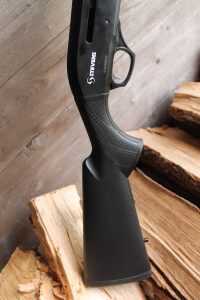
The stock features a textured pistol grip for a sure hold, a generous rubber recoil pad to lessen felt recoil and a rear sling swivel attachment.
I would’ve loved to have had more time to play with this shotgun and experiment with even more loads, different chokes and run more shots through the gun. I think doing so would’ve eked even more top-end performance from the shotgun. It doesn’t yield the level of performance a $1,600 shotgun would be expected to produce, but for just over $500, it definitely yields the level of performance you might expect from a pricier shotgun. It’s definitely a nice shooter that patterns well and for the price, is hard to argue with what you get from it. I wouldn’t hesitate for a moment to take the Stevens S1200 into the duck blind this fall or the turkey woods next spring. On the clays course or the dove field? Play around with your loads first; maybe go with a slightly heavier field load, and the S1200 should work just fine for you there as well.
So, was it just nostalgia making me like this new Stevens shotgun? I don’t think so. With its level of performance and extremely low price tag, it is just common sense to recognize the value of this firearm. And who knows, maybe I’ll make some new memories with this one.
To find out more, visit https://www.savagearms.com/firearms/model/S1200.
To purchase on GunsAmerica.com, click this link: https://www.gunsamerica.com/Search.aspx?T=S1200.


I need a youth version of this type of shotgun with a shorter stock. Is one available, & how much of the stock can I cut off without damaging the gun?
I have a Stoger M3000 that uses the inertia driven system like the more costly Bellini shotguns. It will shoot the light loads #8 & #7 just fine as well as Buck shot & Slugs ( 3 inch to 2 3/4 inch shells). This is a great value at $500.00 so I bought (2) one for hunting and the other I modified for 3 gun. Stoger as makes the model 3500 that will take a 3.5 inch shell for all you duck hunters.
Why is it that only Browning has faith in the 16 gauge, I started out in 1961 shooting a Stevens single shot 16 gauge, that particular weapon went to someone else, but I have an identical model. It is by far the best patterning shotgun of my collection of 16’s. Pump and semi auto. I would be interested in a 16 and would love to see the ammunition folks offer some of the great turkey loads for the 16. Currently Kent patterns the best for me. Just saying a lot of youngster could get 12 gauge results from a light recoil 16. And lots better game than the .410. It requires lots of woodsman skills to sneak up on a squirrel to get one with the venerable .410.
I generally shoot a 100 round box of 6 shot through my Benelli M-1 when I “go paper shooting ”
Unless I let someone who isn’t aware of how to hold onto an “inertia gun” these light loads cycle just fine..it’s a great feeling knowing the gun will cycle the light stuff !
I attribute it to the many,Hundred round boxes of 6-8 shot put through the gun.
I believe the Stevens will benefit from the same treatment.
This is great sharing.thanks .
I picked up an M 3000 in August and love it. It does exactly what I want reliably and I paid $500+ tax for it. I’ve got scatter guns that cost a lot more but stay on the sporting clays course. I would’ve certainly considered the Stevens if I’d have known about them when I picked up the Stoeger.
How about equalizing the audio? Your videos usually have good info but its just as annoying as being told the garbage needs to be taken out when you just sat down to start reloading. Not to mention its like your playing for the other team, cant watch a video without someone accross the house knowing what your watching.
Agree!The audio blast at beginning and end of all the videos is getting old.Get rid of it or tone it down.
Isn’t this action closer to the Browning A5 or the Franchi 48 AL, then the Benelli style
It’s identical to the Stoeger M3000 semi shotgun .
Mine works Great
Doug,
You stated that “It doesn’t yield the level of performance a $1,600 shotgun would be expected to produce, but for just over $500, it definitely yields the level of performance you might expect from a pricier shotgun.”
What exactly does it lack in performance that a $1,600 has? Also, will Stevens have a home defense model available sometime?
I still have a Rem 11-48 running perfectly, don’t what the complaint were about, but this one works first time everytime, with good ammo. But then they all need good ammo.
I have a Benelli M1 and a Franchi Advantage both are inertia driven, I also several other semi autos but I like the inertia system the best. I think this is a excellent concept and should be accept by the average person that wants a quality semi auto action that has been mostly available only in expensive shotguns. Hats off to Stevens for bringing a quality shotgun to the market.
My dad introduced me to Stevens about 1947 being 9 years old at the time.it his was my first experience with a 12 gauge, and was quite exciting and sacred the hell out of me. But dad’s point at the time was to buy quality, and I always did.This new 12 semi looks like a winner.One question, can the owner buy a tube extender so it will double as home protection gun??????? Thanks for a great write up on .
THANK YOU for hearing me! Unlike the $2K+ Benelli Ethos you reviewed back in August, this is much more like something us “average Joe’s” can afford. And I believe most of the gun reviews here on GA are done honestly and are not overly biased like some folks think. Stevens has been around for quite a while. Looks like a decent gun…..at a good reasonable price point to boot. Thanks for the review! Well done.
Inertia driven shotguns have a higher perceived recoil then gas driven, something to consider depending on your usage. The malfunctions with light loads are not uncommon in some inertia and gas semi autos and this is often addressed in he user manuals. No online version availabe from Savage at this time. Many break-in after various amounts of shooting. A friend was told by Benelli to run 250 magnum loads through his M1 (Ouch and spendy): didn’t fix light load problem! My M3 cycles light and heavy fine. If use is dominated by light loads, a change in springs would help if offered by Stevens.